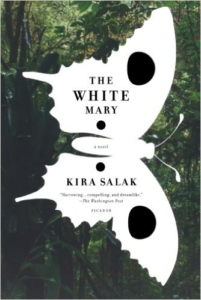 Journalism and Journey
Journalism and Journey
Author: Kira Salak
Combining stoicism with shattering emotion, The White Mary is a unique study in understated, impactful art. Marika Vecera, a character haunted by a nebulous yet horrific past, is now a famed war journalist, traveling to places in open revolt and civil warfare (such as Congo) where even her male counterparts do not dare to go. Business-like and proficient, Marika records the horrors she sees and as she thrives on the chaos and the open flirtation with death, a post-traumatic stress like reaction overtakes her after every near fatal journey. After an abduction and near rape plus murder in the Congo, a shattered Marika returns home to her quiet routine of processing all that she has seen, only to be overwhelmed by her first real love interest, an ex-drug addict named Seb who recognizes the self-destructive nature of smothering emotion and reaction. Forcing Marika to confront what she has lived through instead of stoically presenting the “didn’t hurt” façade she is so famous for, his angst pushes the willful journalist in an appallingly different direction.
Obsessed since her fractured youth by famed war correspondent/expert journalist Robert Lewis, a rumor that Lewis’ suicide was faked leads Marika to leave Seb and the civilized war for a dangerous trek through the heart of Papua New Guinea chasing ghosts and proving herself against all odds. Only, the sickness, the solitude, the superstition, and the strange, fatalistic wisdom of the landscape peopled around her leads Marika towards a deeper, harsher journey into confrontation with all that she has seen and everything she has never owned.
What’s amazing about the story is the fact that while the topics include such hefty items as torture, rape, and ritualistic murder combined with traumatic childhood and devastating relationships, Marika’s practical, quiet tone remains steady throughout, keeping the narrative from melodrama and building the sense of a character with much depth who is essentially in hiding not only from us, but from herself. The multifaceted nature of Marika’s character is most interesting in that she tells us nothing. Instead, loaded flashbacks, tidbits of information (a murdered father and an insane mother) pepper into the narrative, but they remain unassuming. There are no strong waterworks here, no dramatic ups and downs, yet this character-in-denial compels us by the very strength of her resistance and the glimmer we see through that fight of a deeper, tormented individual.
Surrounding Marika, the mythos of Robert Lewis sheds light not only on her but on the dubious world of those who watch, record, and yet never reach out to change the blood rimmed images they casually document. The theme was heavily reminiscent of Kevin Carter’s famous Pulitzer Prize winning photograph, recording a starving child in Sudan with a vulture, waiting in the wings as it were, staring hopefully onward. The debate this famous photograph created, plus its launch of Carter’s fame and his subsequent haunting for having done nothing, although never mentioned in The White Mary picks at the back of readers’ minds. The entire story juxtaposes fame and recognition based on horror with the after effects of such a complicated career choice. Seeing war and death as the “casual observer” has an effect. Living with these effects is devastating. Now take a character already haunted by what she cannot understand, attempting to prove herself and derive value through seeing more meaningless violence and you have a complicated, empathetic narrative with a bittersweet verve underpinning the quiet, malaria drenched jungle scenes.
Also worth mentioning is Tobo, the witch doctor who through superstition and a feeling of responsibility is tasked with taking Marika, or as he refers to her the demon-possessed wild eyed White Mary, across a landscape he is sure she cannot survive. Sure that he will be haunted by her dissolute spirit in the event of failure and also certain that she will never make her goal, Tobo combines wild superstitions and ignorance with an amazingly rapacious wisdom and an appealingly characterized cynicism. Tobo, although a side character, often steals the show and it is through the third person omniscience of the language that we casually drop in and out of his head, allowing his pragmatism and dread to color our portrait of Marika’s strange quest.
While it’s evident that the journey (aka quest) is one of self-discovery and the ending is destined to be one of realization (however abruptly reached), The White Mary has plenty of surprises and unanswered questions along the way. At the conclusion, we’re not quite sure that we’ve sorted through all the murky depths, especially of Lewis, to reveal full cause-and-effect or even understand some of the broader strokes of the narrative. Normally, this would be irritating yet here, it has a sense of realism and a smattering of a long journey peppered with awakening perception still overload with the static of confusion and half-formed assumptions. It’s the deep uncertainty of why we are the way we are and why we react the way we do that makes this story far more than just a jungle adventure. Instead, The White Mary breathes the complexity of true literature and begs audiences for multiple re-reads and open conjecture. In the end, however, like Marika, we see the glimmer and we understand just enough to get by with the understanding. In the end, we know that there are many long nights ahead where we must puzzle out the rest of the all those unanswered things.
– Frances Carden
Follow my reviews on Twitter at: https://twitter.com/xombie_mistress
Follow my reviews on Facebook at: https://www.facebook.com/FrancesReviews/
- Book Vs Movie: The Shining - April 6, 2020
- Thankful For Great Cozy Mysteries - December 13, 2019
- Cozy Mysteries for a Perfect Fall - October 20, 2019

